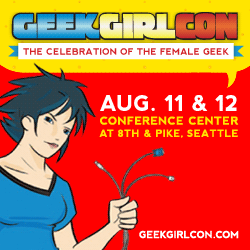Fangirls Around the Web: August 20, 2012
Featuring heroines – real and fictional – spotted around the web last week.
One of the best parts about GeekGirlCon is getting a chance to meet new people and make new connections. On Sunday I strolled over to the GeekGirlConnections room. I talked to the women from NASA about their panel, and also followed up with Ashley Eckstein after Saturday’s Star Wars panel.  Shiromi Arserio was taking the opportunity to ask advice of Ashley, and as it turned out Ashley suggested I might be able to answer one of her questions about blogging and social media. Part of my advice was to always tweet a new post multiple times to account for the speed at which Twitter travels. Shiromi followed that advice with an “In Case You Missed It” tweet, and that’s how I caught her article on the convention.
Shiromi Arserio was taking the opportunity to ask advice of Ashley, and as it turned out Ashley suggested I might be able to answer one of her questions about blogging and social media. Part of my advice was to always tweet a new post multiple times to account for the speed at which Twitter travels. Shiromi followed that advice with an “In Case You Missed It” tweet, and that’s how I caught her article on the convention.
After a sexist cartoon about GeekGirlCon popped up last week, Amy Ratcliffe discussed the conundrum of pointing out these types of misogyny. Amy will be writing for the Star Wars Blog this week from Celebration VI, so be sure to check out her reports.
A friend mentioned that I should check out the EW.com article on Brenda Chapman, the original director of Pixar’s Brave who was later replaced. In a New York Times article this week, she opens up about being removed from the movie. It’s impossible to say if her removal was the wrong or the right move for the movie or Chapman, but it is true that women have fewer chances at the top jobs in the entertainment industry. When talking to women with STEM careers at GeekGirlCon, they all noted similar difficulties in the fields of engineering and science.
Animation directors are not protected like live-action directors, who have the Directors Guild to go to battle for them. We are replaced on a regular basis – and that was a real issue for me. This was a story that I created, which came from a very personal place, as a woman and a mother. To have it taken away and given to someone else, and a man at that, was truly distressing on so many levels. But in the end, my vision came through in the film. It simply wouldn’t have worked without it (and didn’t at one point), and I knew this at my core. So I kept my head held high, stayed committed to my principles, and was supported by some strong women (and men!). In the end, it worked out, and I’m very proud of the movie, and that I ultimately stood up for myself, just like Merida, the protagonist in “Brave.”
Sometimes women express an idea and are shot down, only to have a man express essentially the same idea and have it broadly embraced. Until there is a sufficient number of women executives in high places, this will continue to happen.
That’s just one story of a few I could share. I know there are so many more out there to prove we can move up that food chain. But we must be persistent.
Mentor. Inspire. Move forward together. That’s the best I can think of.
Brenda Chapman is now working with Lucasfilm on a yet-to-be announced project.
Speaking of women creating entertainment, Danica Davidson’s piece at the CNN Geek Out blog about the success of manga among female readers seems timely.
Brenner gave a little more background on the history of women and manga: “In the 1970s, Japanese editors of manga magazines decided to try something new. They’d been producing comics for girls and young women since the 1950s, but they were never a roaring success. They already had a number of female creators working in the business, so they smartly asked: if we want to sell comics to girls and women, why don’t we hire some women to create them? Thus, a number of legendary female creators got their start as primary artists on a number of famous girls titles (‘Rose of Versailles,’ ‘To Terra,’ ‘From Eroica with Love’)”
As a result, she said, from that point on, many creators of girls’ and women’s manga were women. “They introduced elements that their male colleagues could not have predicted, and diversified the kind of content appearing in manga aimed at girls and women. They also developed an artistic vocabulary distinct from shonen or seinen manga that is recognizable and distinctive,” she said.
This is exactly why I’d like to see more female (and different) storytellers in the Star Wars Expanded Universe, in hopes that they can find a way to create stories that connect with female fans.
And finally, here’s a little proof that perhaps with the success of movies like The Hunger Games and television shows like The Legend of Korra, Hollywood finally might be taking notice of the power of the heroine: TheMarySue.com reports that a cast of female action stars are being considered for the next Expendables movie.
- Hyperspace Theories: Bad Luck Ghorman - June 2, 2025
- Hyperspace Theories: One Year Later as ANDOR Kicks Off Season Two - May 15, 2025
- REVIEW: Tales of the Underworld - May 4, 2025










